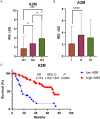Prognostic significance of alpha-2-macrglobulin and low-density lipoprotein receptor-related protein-1 in various cancers
- PMID: 39005669
- PMCID: PMC11236788
- DOI: 10.62347/VUJV9180
Prognostic significance of alpha-2-macrglobulin and low-density lipoprotein receptor-related protein-1 in various cancers
Abstract
Cancer is the leading cause of death worldwide. The World Health Organization (WHO) estimates that 10 million fatalities occurred in 2023. Breast cancer (BC) ranked first among malignancies with 2.26 million cases, lung cancer (LC) second with 2.21 million cases, and colon and rectum cancers (CC, CRC) third with 1.93 million cases. These results highlight the importance of investigating novel cancer prognoses and anti-cancer markers. In this study, we investigated the potential effects of alpha-2 macroglobulin and its receptor, LRP1, on the outcomes of breast, lung, and colorectal malignancies. Immunohistochemical staining was used to analyze the expression patterns of A2M and LRP1 in 545 cases of invasive ductal breast carcinoma (IDC) and 51 cases of mastopathies/fibrocystic breast disease (FBD); 256 cases of non-small cell lung carcinomas (NSCLCs) and 45 cases of non-malignant lung tissue (NMLT); and 108 cases of CRC and 25 cases of non-malignant colorectal tissue (NMCT). A2M and LRP1 expression levels were also investigated in breast (MCF-7, BT-474, SK-BR-3, T47D, MDA-MB-231, and MDA-MB-231/BO2), lung (NCI-H1703, NCI-H522, and A549), and colon (LS 180, Caco-2, HT-29, and LoVo) cancer cell lines. Based on our findings, A2M and LRP1 exhibited various expression patterns in the examined malignancies, which were related to one another. Additionally, the stroma of lung and colorectal cancer has increased levels of A2M/LRP1 areas, which explains the significance of the stroma in the development and maintenance of tumor homeostasis. A2M expression was shown to be downregulated in all types of malignancies under study and was positively linked with an increase in cell line aggressiveness. Although more invasive cells had higher levels of A2M expression, an IHC analysis showed the opposite results. This might be because exogenous alpha-2-macroglobulin is present, which has an inhibitory effect on several cancerous enzymes and receptor-dependent signaling pathways. Additionally, siRNA-induced suppression of the transcripts for A2M and LRPP1 revealed their connection, which provides fresh information on the function of the LRP1 receptor in A2M recurrence in cancer. Further studies on different forms of cancer may corroborate the fact that both A2M and LRP1 have high potential as innovative therapeutic agents.
Keywords: A2M; Breast cancer; CC; IDC; LRP1; NSCLC; alpha-2-macroglobulin; colorectal cancer; low-density lipoprotein receptor-related protein-1; lung cancer.
AJCR Copyright © 2024.
Conflict of interest statement
None.
Figures










Similar articles
-
Association study of the A2M and LRP1 Genes with Alzheimer disease in the Han Chinese.Biol Psychiatry. 2005 Nov 1;58(9):731-7. doi: 10.1016/j.biopsych.2005.05.013. Epub 2005 Jul 25. Biol Psychiatry. 2005. PMID: 16040006
-
Association of polymorphisms in the LRP1 and A2M genes with Alzheimer's disease in the northern Chinese Han population.J Clin Neurosci. 2013 Feb;20(2):253-6. doi: 10.1016/j.jocn.2012.01.052. Epub 2012 Nov 24. J Clin Neurosci. 2013. PMID: 23186781
-
LRP1-dependent pepsin clearance induced by 2'-hydroxycinnamaldehyde attenuates breast cancer cell invasion.Int J Biochem Cell Biol. 2014 Aug;53:15-23. doi: 10.1016/j.biocel.2014.04.021. Epub 2014 May 4. Int J Biochem Cell Biol. 2014. PMID: 24796846
-
Alpha-2-macroglobulin in hemostasis and thrombosis: An underestimated old double-edged sword.J Thromb Haemost. 2022 Apr;20(4):806-815. doi: 10.1111/jth.15647. Epub 2022 Jan 30. J Thromb Haemost. 2022. PMID: 35037393 Review.
-
The Matricellular Receptor LRP1 Forms an Interface for Signaling and Endocytosis in Modulation of the Extracellular Tumor Environment.Front Pharmacol. 2015 Nov 10;6:271. doi: 10.3389/fphar.2015.00271. eCollection 2015. Front Pharmacol. 2015. PMID: 26617523 Free PMC article. Review.
Cited by
-
The Anti-Metastatic Properties of Glutathione-Stabilized Gold Nanoparticles-A Preliminary Study on Canine Osteosarcoma Cell Lines.Int J Mol Sci. 2025 Jun 25;26(13):6102. doi: 10.3390/ijms26136102. Int J Mol Sci. 2025. PMID: 40649877 Free PMC article.
-
Targeting A2M-LRP1 reverses uterine spiral artery remodeling disorder and alleviates the progression of preeclampsia.Cell Commun Signal. 2025 Feb 24;23(1):107. doi: 10.1186/s12964-025-02060-y. Cell Commun Signal. 2025. PMID: 39994728 Free PMC article.
-
Application of Cord Blood-Derived Exosomes in Tumor Prevention and Treatment.Clin Med Insights Oncol. 2025 Aug 10;19:11795549251365360. doi: 10.1177/11795549251365360. eCollection 2025. Clin Med Insights Oncol. 2025. PMID: 40799502 Free PMC article. Review.
References
-
- Heim D, Budczies J, Stenzinger A, Treue D, Hufnagl P, Denkert C, Dietel M, Klauschen F. Cancer beyond organ and tissue specificity: next-generation-sequencing gene mutation data reveal complex genetic similarities across major cancers. Int J Cancer. 2014;135:2362–2369. - PubMed
-
- Newton Y, Novak AM, Swatloski T, McColl DC, Chopra S, Graim K, Weinstein AS, Baertsch R, Salama SR, Ellrott K, Chopra M, Goldstein TC, Haussler D, Morozova O, Stuart JM. TumorMap: exploring the molecular similarities of cancer samples in an interactive portal. Cancer Res. 2017;77:e111–e114. - PMC - PubMed
LinkOut - more resources
Full Text Sources
Research Materials
Miscellaneous
